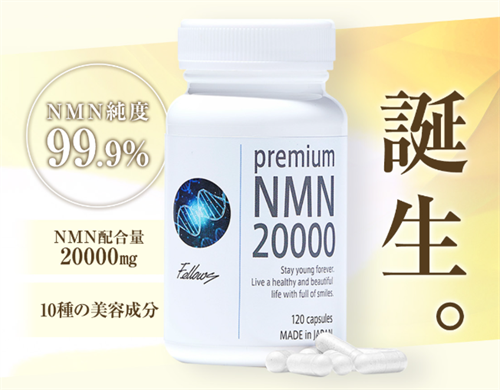
Premium NMN 20000の良い口コミ・悪い口コミをまとめて徹底解説。
NMNの含有量や10種類の美容成分の魅力、定期購入のメリットまで、購入前に知っておきたい情報をひとまとめ。
実際に使った体験談も掲載中。
年齢とともに衰えを感じ始めた方々の間で注目を集めているPremium NMN 20000。
その最大の魅力は、1瓶に20,000mgという業界トップクラスの高純度NMNを配合している点です。
しかもNMNの働きをサポートする10種類の美容成分も贅沢に含まれており、エイジングケアを本気で考える方にぴったりなサプリメントです。
GMP認定の国内工場で製造され、品質や安全性も折り紙つきです。
実際に愛用している方々からは以下のような口コミが寄せられています。
- 毎朝の目覚めがスッキリするようになった
- 肌にハリが戻った感じがしてうれしい
- 3か月飲み続けたら明らかに疲れにくくなった
- 小粒で飲みやすく、続けやすいのが助かる
- 夫婦で一緒に始めて体の調子が整った気がする
\ 高濃度NMNで理想の自分を! /
目次
- 1 Premium NMN 20000の口コミ・評判を徹底検証してわかった本当の実力とは
- 2 Premium NMN 20000の悪い口コミ・評判をリアルに紹介!購入前に知っておきたい体験談集
- 3 Premium NMN 20000の良い口コミ・評判を紹介!実感されたリアルな声まとめ
- 4 Premium NMN 20000のXでの口コミ
- 5 Premium NMN 20000の効果について実際に試した私の口コミをご紹介
- 6 Premium NMN 20000の特徴を徹底解説!なぜ選ばれているのかその理由とは
- 7 Premium NMN 20000をおすすめする人・しない人を徹底解説!後悔しないためのチェックポイント
- 8 Premium NMN 20000のQ&A集!購入前に気になる疑問をすべて解決
- 9 Premium NMN 20000の口コミ・評判まとめ!美と健康を本気で目指す女性に選ばれる理由
Premium NMN 20000の口コミ・評判を徹底検証してわかった本当の実力とは
実際にPremium NMN 20000を使用した方の感想には、「肌の調子が良くなった」「疲れにくくなった」といった良い声が多く見られます。
一方で、「効果を感じにくい」「価格が少し高い」といった正直な意見も存在しています。
ここでは、良い評価だけでなく、ネガティブな意見も包み隠さず取り上げ、購入前に知っておきたいリアルな口コミを公平にご紹介します。
Premium NMN 20000の悪い口コミ・評判をリアルに紹介!購入前に知っておきたい体験談集
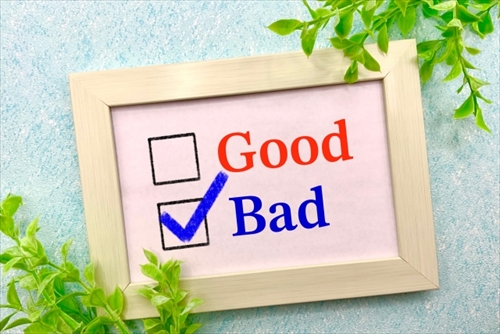
Premium NMN 20000は多くの人に選ばれている話題のサプリメントですが、実際に使ってみた方の中には満足できなかったという声もあります。
ここでは、購入して使用した方々の本音を集め、リアルな使用感をそのままお届けします。
好意的な意見だけでなく、やや期待外れだったという声にも目を向けておきましょう。
※個人の感想であり効能効果を表すものではございません。
- 効果を実感できなかった
- Premium NMN 20000は価格が高いと感じた
- 短期間では変化が分からなかった
Premium NMN 20000は効果を実感できなかった
1ヶ月ほど毎日飲み続けてみたのですが、正直なところ特に目に見える変化は感じられませんでした。
肌の状態や寝つきなどにも大きな変化はなく、普段とほとんど変わらないまま過ごした印象です。
口コミで期待していた分、もう少し早く何か実感できたら嬉しかったのですが、私には合っていなかったのかもしれません。
Premium NMN 20000は価格が高いと感じた
品質や成分が良いのは分かりますが、毎月続けるにはやはり価格がネックになります。
定期購入でも安くなるとはいえ、他のサプリと比べても高めだと思いました。
効果がすぐに出るわけではないので、コスパ的に続けるのが少し悩ましいです。
もう少し気軽に試せる価格設定ならありがたいですね。
Premium NMN 20000は短期間では変化が分からなかった
期待していた分、3週間ほど飲んでも目立った変化がなくて少し残念でした。
肌の調子や疲れやすさに関してもあまり変化は感じず、やはり最低でも2~3ヶ月は続けないと意味がないのかなという印象でした。
気長に続ける覚悟が必要だと思います。
Premium NMN 20000の良い口コミ・評判を紹介!実感されたリアルな声まとめ
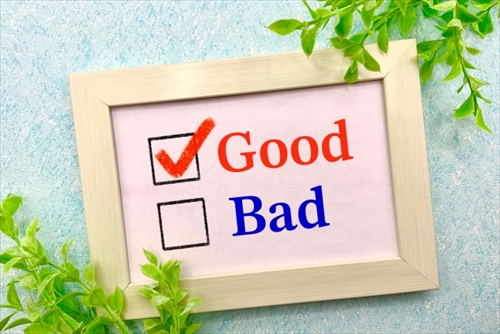
Premium NMN 20000は高品質なNMNと美容成分の豊富な配合で、多くの方から高評価を得ている人気サプリです。
実際に使用してみた方々からは、美容面だけでなく体調や活力面でも嬉しい変化を感じたという声がたくさん届いています。
ここでは、実際の利用者から寄せられたリアルな感想をわかりやすくご紹介します。
※個人の感想であり効能効果を表すものではございません。
- 朝の目覚めがすっきりして体が軽くなった
- Premium NMN 20000で肌のハリやツヤが変わった
- 疲れにくくなり夕方のだるさが減った
- 寝つきが良くなりぐっすり眠れるようになった
- 年齢より若く見られることが増えてうれしい
- 肌のくすみが取れて明るくなった感じがする
- Premium NMN 20000は飲みやすくて習慣にしやすい
- 運動後の回復が早くなった気がする
Premium NMN 20000で朝の目覚めがすっきりして体が軽くなった
以前は朝なかなか布団から出られず、ずっとだるさを感じていましたが、Premium NMN 20000を飲み始めて1週間ほどで、朝の目覚めが明らかに変わりました。
目がパチッと開いて体も軽く、すぐに活動できるようになったのです。
今では朝の準備時間にも余裕ができて、1日のスタートがとてもスムーズになりました。
こんな変化があるなんて思っていなかったので、驚いています。
Premium NMN 20000で肌のハリやツヤが変わった
年齢とともに感じていた肌のたるみや乾燥に悩んでいたのですが、Premium NMN 20000を飲み始めてから、肌の内側からふっくらしてきたように感じています。
メイクのノリもよくなり、鏡を見るのが楽しくなりました。
特に頬のハリが出てきて、化粧水の入り方まで変わったように感じます。
美容クリームを変えたわけではないので、これはサプリのおかげだと思っています。
Premium NMN 20000で疲れにくくなり夕方のだるさが減った
仕事が忙しく夕方になるとぐったりする日が多かったのですが、Premium NMN 20000を続けていると、明らかに疲労感が軽減されてきました。
以前は帰宅すると何もする気が起きなかったのに、今では夕飯の準備も苦にならず動けています。
週末もアクティブに過ごせるようになったのは大きな変化です。
体の中から元気になっている感じがします。
Premium NMN 20000で寝つきが良くなりぐっすり眠れるようになった
寝付きが悪くていつも寝るまでに時間がかかっていたのですが、Premium NMN 20000を飲み始めてから、布団に入ると自然と眠れるようになりました。
眠りも深くなり、朝までぐっすり眠れるようになったのが嬉しいです。
以前は夜中に何度も目が覚めていたのが嘘のようです。
睡眠が改善されると、日中の集中力も上がるように感じます。
Premium NMN 20000で年齢より若く見られることが増えてうれしい
3ヶ月位飲み続けて、最近、周囲の人から「若くなった?」と言われることが増えて、とても嬉しくなりました。
自分では気づかなかったのですが、顔の印象が明るくなったり、目元がはっきりしてきたと言われます。
年齢による衰えを感じ始めていたので、こういった言葉は本当に励みになります。
若々しさを保ちたい方には試してみてほしいです。
Premium NMN 20000で肌のくすみが取れて明るくなった感じがする
もともと色白ではないので、肌がくすんで見えるのが気になっていました。
でもPremium NMN 20000を取り入れてから、ファンデーションを塗る前でも肌がトーンアップしたように見えるようになりました。
スキンケアの手応えを感じていなかった私には、とても大きな変化です。
内側から透明感が出てくるというのはこういうことなのかもしれません。
Premium NMN 20000は飲みやすくて習慣にしやすい
サプリメントは続かないことが多かったのですが、Premium NMN 20000はカプセルが小さくて飲みやすく、毎日の習慣にしやすいと感じました。
朝のルーティンの中にすっと溶け込んで、飲み忘れも少ないです。
味や匂いも気にならないので、ストレスなく続けられています。
体に良いことをしている実感があるのもモチベーションにつながっています。
Premium NMN 20000で運動後の回復が早くなった気がする
趣味でジョギングをしているのですが、Premium NMN 20000を飲むようになってから、運動後の疲れが残りにくくなったように感じます。
以前は翌日に筋肉痛が残っていたのが、今ではスッと回復するようになりました。
体力の衰えを感じ始めていたので、この違いは本当にありがたいです。
運動する人にもおすすめしたいサプリです。
\ 高濃度NMNで理想の自分を! /
Premium NMN 20000のXでの口コミ
Xでの口コミを見ていきましょう。
コエタスのモニターキャンペーンでもらった【 Premium NMN 20000 】についてのレビューです😊#PR#コエタス #スリーナイン #NMN20000 #NMN #NMNサプリ #サプリメント #美容サプリ #エイジングケア
Premium NMN20000は、一瓶120粒で業界トップクラスのβ-NMN20,000㎎配合✨… pic.twitter.com/H9UlbfYqGw? おゆみ🍀美容×サウナライター (@mnst_ts) September 12, 2024
![]() 美容と健康の両方を大切にしたい人には、とても魅力的な内容に感じます。
美容と健康の両方を大切にしたい人には、とても魅力的な内容に感じます。
NMNと一緒に美容成分も摂れるのは手軽で嬉しいですし、毎日無理なく続けられるカプセルタイプというのもポイントが高いですね。
効果に期待が持てそうです。
コエタスのモニターキャンペーンでもらった「Premium NMN 20000」についてのレビューです。
◆ Premium NMN 20000
価格:14200円(税込)、120粒入そもそもNMNとは?
ビタミンB3に含まれる成分で、加齢とともに減少します。α型とβ型があり、α型は体で作られないので、β型NMNが◎ pic.twitter.com/q07H87lHDi
?☆Megumi☆(@happymegumi) February 6, 2025
![]() NMNについてわかりやすく説明されていて、初めて聞いた人でも理解しやすい内容だと感じました。
NMNについてわかりやすく説明されていて、初めて聞いた人でも理解しやすい内容だと感じました。
特にβ型が良いというポイントは購入時の判断材料になりますね。
価格だけを見ると少し高めですが、その価値がありそうです。
コエタスのモニターキャンペーンで
いただいた
【Premium NMN 20000】に
ついてのレビューです✍️
若返りのサプリとしても話題✨
一瓶120粒で業界トップクラスのβ-NMN20000㎎配合☺?
小粒なカプセルなので
喉にひっかかることなく
飲みやすいです🙆♀️⭕
1日4粒を目安に服用します🫶 pic.twitter.com/ym0PNwotgp? 🍃🥀🌿coco🌿🪷🍃 (@ssyy18657) January 9, 2025
![]() 若返りのサプリとして注目されている理由がよく伝わってきます。
若返りのサプリとして注目されている理由がよく伝わってきます。
高配合なのに小粒で飲みやすいという点は、継続のしやすさにもつながりそうですね。
飲みづらさがないのは意外と大きなポイントだと感じました。
毎日の習慣に取り入れやすそうです。
コエタスのモニターキャンペーンでもらったPremium NMN 20000 についてのレビューです。
20,000㎎はすごいです、業界トップクラス!最近そういえば化粧ノリが良い気がする~肌の乾燥が気にならい、、、など感じています。
#コエタス #PR #スリーナイン #NMN20000 #NMN #NMNサプリ #サプリメント pic.twitter.com/gT55jzsOWV
? tea (@teatea112233) October 2, 2024
![]() NMNの含有量が業界トップクラスというのは、とても信頼感がありますね。
NMNの含有量が業界トップクラスというのは、とても信頼感がありますね。
化粧ノリや乾燥の変化を実感できるのは、内側からのケアがきちんと届いている証拠だと思いました。
目に見える効果があると、続けるモチベーションにもつながります。
コエタス様のモニターにて当選した「Premium NMN 20000」について✨
1粒に166.7mgのNMNが含有されてるから3粒飲むと1日に500㎎のNMNが摂取できる🎶
カプセルだから臭いとかなくてツルンと飲みやすい👍
飲み始めてからお肌の調子がいい👍#コエタス #PR#スリーナイン #NMN20000 #NMN #エイジングケア pic.twitter.com/legNdSnx0k? hima🐘🎀タイクレハマり中💓 (@zuboramama2019) September 27, 2024
![]() NMNの摂取量がしっかり明記されていて、成分を意識して選びたい人にも安心感があります。
NMNの摂取量がしっかり明記されていて、成分を意識して選びたい人にも安心感があります。
臭いがなくて飲みやすいという点は、毎日続けるうえで大事なポイントですね。
肌の調子が良くなったという実感もあり、効果への期待が高まります。
\ 高濃度NMNで理想の自分を! /
Premium NMN 20000の効果について実際に試した私の口コミをご紹介

年齢を重ねるごとに「最近、疲れやすくなったな」「肌のハリがなくなってきたかも…」と感じていた私。
美容や健康に良いと話題のNMNをいろいろ調べていく中で、国産で高純度のNMNが配合されたPremium NMN 20000に出会いました。
美容成分もたっぷり含まれていて、信頼できる品質が決め手となり、思い切って購入。
私が実際にPremium NMN 20000を3ヶ月間試した感想を、女性目線でお伝えします。
| 期間 | 感じたこと |
|---|---|
| 初めて試した | 寝つきが良くなり、翌朝スッキリ |
| 1ヶ月後 | 肌のツヤ・透明感、目覚めの変化、活力UP |
| 3ヶ月後 | 肌にハリ、若く見られる、疲れ知らずの体へ |
※個人の感想であり効能効果を表すものではございません。
Premium NMN 20000を初めて試した感想
初めて飲んだのは、夜の食後。
カプセルは透明で無味無臭。
サイズも小さめで飲みやすく、抵抗感はありませんでした。
正直なところ、初日は特に何も感じないと思っていたのですが、なんと翌朝が違いました。
いつもよりぐっすり眠れた感覚があり、朝の目覚めが軽く、頭も体もスッキリしていました。
「あれ? なんか違うかも」と思えたこの感覚が、初日からの手応えにつながりました。
さらに驚いたのが、肌の乾燥が少し和らいだこと。
朝の洗顔時に、肌がもっちりとしていて、ファンデのノリも良くなったように感じました。
サプリを飲んだだけでこんなに違いが出るのかと、正直びっくり。
1日でも違いがわかるって、すごいことだと思います。
Premium NMN 20000を1ヶ月試した感想
1ヶ月続けていると、確実に変化がありました。
まず毎朝の目覚めが本当に快適で、アラームより先に自然と目が覚めるようになったんです。
以前は寝ても寝ても疲れが抜けず、週末はぐったりしていたのに、今では平日も元気に動けています。
「体がちゃんと回復している」実感があるのは、生活の質を大きく変えてくれました。
そして、肌のツヤと明るさ。
以前はくすみがちだった私の顔色がワントーン明るくなり、メイクが楽しくなってきました。
鏡を見るのが楽しみになるって、女性にとってはとても大切なことですよね。
友人にも「何か始めた?肌がキレイ」と聞かれて、自分でも嬉しくなりました。
ハリや弾力も少しずつ戻ってきて、年齢肌への不安が減っていくのを感じました。
Premium NMN 20000を3ヶ月試した感想
3ヶ月が経った頃、心も体も以前とは明らかに違っていました。
まず、日々の疲れがたまりにくくなったと感じます。
仕事に家事に忙しい毎日でも、「疲れた…」という言葉を口にしなくなりました。
そして、なによりも印象的だったのは「若くなった?」と声をかけられたこと。
久しぶりに会った友人に「なんか雰囲気変わったね、若返った?」と言われたのがとても嬉しかったです。
肌にハリが出てきて、フェイスラインがキュッと引き締まった感じ。
メイクのノリはもちろん、すっぴんのときでも自信が持てるようになったのは、Premium NMN 20000のおかげだと思っています。
さらに、イライラや落ち込みが減って気持ちも前向きに。
NMNって、単なる美容サプリではなく、全身に働きかけてくれる力があるんだなと実感しました。
Premium NMN 20000を試した私の感想まとめ
Premium NMN 20000を3ヶ月間試したことで、肌・体・気分のすべてに嬉しい変化を感じました。
朝の目覚めがスムーズになり、肌が潤い、気持ちまで前向きになれたのは本当に大きな成果でした。
年齢を重ねてもキレイで元気な自分でいたい。
そんな願いにそっと寄り添ってくれる、信頼できるサプリだと感じています。
\ 高濃度NMNで理想の自分を! /
Premium NMN 20000の特徴を徹底解説!なぜ選ばれているのかその理由とは
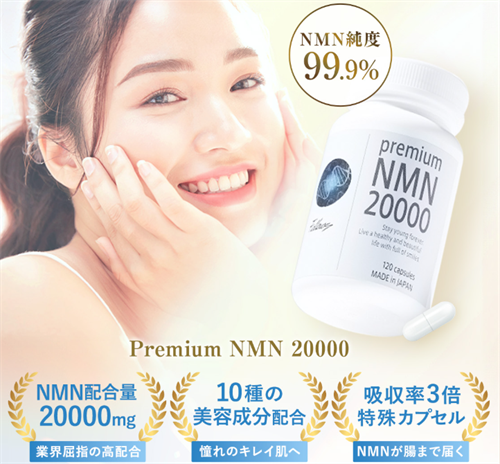
近年、健康意識や美容ケアの高まりとともに注目を集めている成分「NMN」。
中でもPremium NMN 20000は、高純度で高配合、さらに美容と健康の両面にアプローチすることで多くの支持を集めているサプリメントです。
Premium NMN 20000が選ばれる理由を、具体的な特徴とともに詳しくご紹介します。
| 特徴 | 内容 |
|---|---|
| 高純度NMN | 国産・高純度99.9%のNMNを配合。
品質と安全性にこだわり、安心して摂取できる。 |
| 高配合量 | 1瓶に20,000mg配合。
1日4粒で666mg摂取できる業界トップクラスの含有量。 |
| 美容成分配合 | レスベラトロール・コエンザイムQ10・セラミドなど10種類の美容成分を贅沢に配合。 |
| 耐酸性カプセル | 胃酸に負けずに腸まで届く。
一般的なカプセルの最大3倍の吸収率(※自社比)。 |
| GMP認定工場製造 | 医薬品レベルの品質管理。
国内GMP認定工場で製造されているため信頼性が高い。 |
| 天然酵素製法 | 有機触媒を一切使わない、環境にもやさしいナチュラル製法。 |
| 定期購入の自由度 | 回数縛りなし。
初回40%OFF8,520円(税込) 2回目以降も30%OFF9,940円(税込)で気軽に始めやすい。 |
高純度99.9%の国産NMNを配合
Premium NMN 20000の大きな特徴のひとつが、高純度99.9%の国産NMNが使用されているという点です。
NMNの品質は純度に大きく左右されるため、この数値は非常に重要です。
国内で製造されていることからも、安全性と信頼性が高く、品質にこだわる方にも安心して選ばれています。
業界トップクラスの配合量20,000mg
NMNの含有量が多ければ多いほど、体内でのサポート力も期待できます。
Premium NMN 20000は、一瓶あたり20,000mgという業界トップクラスの高配合。
1日あたり4粒で666mgを摂取でき、継続的にしっかりNMNを取り入れたい方に最適な量です。
手軽に高濃度NMNを補えるのは大きな魅力です。
美容成分を10種類も配合
NMNだけでなく、美容をサポートする厳選成分が10種類配合されているのも大きなポイントです。
レスベラトロール、コエンザイムQ10、セラミド、コラーゲンなど、女性に嬉しいエイジングケア成分を一度に摂れるオールインワンサプリ。
内側から美を整えたい人にぴったりです。
吸収率を高める耐酸性カプセルを採用
サプリメントの効果を左右するのが「吸収率」。
Premium NMN 20000は、胃酸で分解されにくい耐酸性カプセルを採用しています。
小腸までしっかり届いて成分を無駄なく吸収。
一般的なカプセルに比べて最大3倍の吸収率を誇る(※自社比)点が特長です。
国内GMP認定工場での製造
品質管理の徹底されたGMP認定工場で製造されているのも安心ポイントです。
医薬品レベルの製造基準に則って生産されているため、品質に不安を感じることなく、毎日口にできる安全性があります。
日本国内製造という信頼感も、多くのリピーターを生んでいます。
天然酵素製法で安心・安全
Premium NMN 20000に使用されているNMNは、有機触媒を使用しない「天然酵素製法」によって抽出されています。
化学合成ではなく、自然に近い製法で作られているため体にも環境にもやさしいのが魅力。
添加物などに敏感な方にも安心して選ばれています。
定期購入でも縛りなしで続けやすい
Premium NMN 20000の定期コースは、回数縛りがなく初回からでも解約が可能です。
さらに、初回は40%OFF8,520円(税込)、2回目以降も30%OFF9,940円(税込)という割引価格で続けられるのも魅力。
続けることで効果を実感しやすいサプリだからこそ、無理なく始められる仕組みが整っているのはありがたいですね。
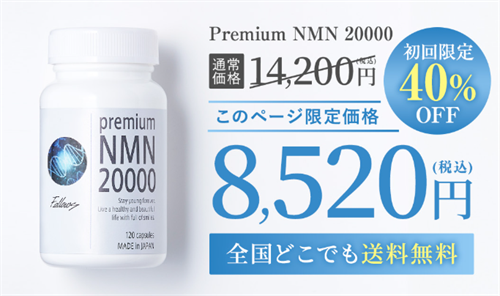
\ 高濃度NMNで理想の自分を! /
Premium NMN 20000をおすすめする人・しない人を徹底解説!後悔しないためのチェックポイント

サプリメント選びで失敗しないためには、商品が「どんな人に合っていて、どんな人には向かないのか」を事前に把握しておくことが大切です。
Premium NMN 20000は高品質なNMNと美容成分を配合したサプリですが、すべての人に万能というわけではありません。
ここでは、実際の使用目的や生活スタイルをもとに、「おすすめしない人」と「おすすめする人」をそれぞれご紹介します。
Premium NMN 20000をおすすめしない人
- サプリより食事や運動に重きを置きたい人
- 価格の安さを最優先したい人
- カプセルを飲むのが苦手な人
- 成分にこだわりが強く独自の健康法を持っている人
以下では、なぜこのような人には向いていないのかを詳しく解説します。
サプリより食事や運動に重きを置きたい人
健康維持にはバランスのとれた食事や運動が重要ですが、中には「自然な方法で整えたい」という考えを持つ方もいます。
そうした方にとって、サプリに頼ること自体に抵抗があると、Premium NMN 20000の価値を実感しづらい可能性があります。
ライフスタイルとの相性が大事です。
価格の安さを最優先したい人
Premium NMN 20000は高品質・高配合ゆえに価格はやや高めです。
コストパフォーマンスは高いとはいえ、「安ければ何でもいい」と考える方には向いていない商品です。
価格より品質を重視する人にこそ適したアイテムです。
カプセルを飲むのが苦手な人
小粒で飲みやすい設計にはなっていますが、それでも「錠剤やカプセルが苦手」という方も一定数います。
サプリの形状に敏感な方にとっては、毎日の継続がストレスになる可能性があります。
粉末やドリンク型の方が合っている人もいるかもしれません。
成分にこだわりが強く独自の健康法を持っている人
特定の栄養素や製法に対して強いこだわりを持っている方や、独自の健康法を実践している方は、他のサプリとの相性なども気にされることが多いです。
そうした方にとっては、自分のスタイルに合わない可能性もあるため注意が必要です。
Premium NMN 20000をおすすめする人
- 年齢による変化を感じ始めた女性
- エイジングケアに本気で取り組みたい人
- 肌のハリや明るさを求めている人
- 疲れやすさを感じるようになった人
- 忙しくても健康と美容を両立したい人
- 安心・安全な国内製造にこだわりたい人
- 成分に信頼を置きたい人
- 毎日の習慣として継続しやすいサプリを探している人
自分をもっと好きになりたい、年齢に負けたくないという女性にぴったりのサプリメントです。
以下では、具体的にどのような人に合っているのかをご紹介します。
年齢による変化を感じ始めた女性
肌の乾燥、小じわ、疲れやすさなど、年齢を重ねるごとに感じる小さな変化。
Premium NMN 20000は、その変化に気づき始めたタイミングでこそ取り入れたいサプリメントです。
早めにエイジングケアを始めることで、未来の自分に差がつきます。
エイジングケアに本気で取り組みたい人
単なる美容ではなく、細胞レベルから若々しさを維持したいと考えている方にとって、NMNの力は非常に有効です。
ハーバード大学などの研究でも注目されている成分を本気で取り入れたい人には最適です。
肌のハリや明るさを求めている人
美容成分が10種類も配合されているため、内側からのケアをしたい方にぴったりです。
肌のくすみやハリ不足を感じている方には嬉しい変化が期待できます。
メイクが映える肌を目指す人に支持されています。
疲れやすさを感じるようになった人
最近なんだか疲れやすい、回復が遅くなった…と感じている人には、Premium NMN 20000の活力サポートが役立ちます。
日々のエネルギー不足を根本から見直したい方におすすめです。
忙しくても健康と美容を両立したい人
仕事や家事に追われてなかなか自分のケアに時間をかけられない…。
そんな方にもPremium NMN 20000はぴったり。
毎日数粒飲むだけで、体と肌をまとめてケアできる手軽さが魅力です。
安心・安全な国内製造にこだわりたい人
サプリメントは毎日体に入れるものだからこそ、安全性は重要なポイント。
Premium NMN 20000は国内GMP認定工場で製造されており、信頼性の高い日本製という点で安心感があります。
成分に信頼を置きたい人
β-NMNの純度は99.9%、さらに天然酵素製法で抽出されているなど、こだわりのある成分設計。
成分の質を最優先に選びたい人にとって、理想的なサプリメントです。
毎日の習慣として継続しやすいサプリを探している人
飲みやすいカプセルタイプで、味やにおいもほとんど気にならず、毎日の習慣に取り入れやすいのが特徴。
続けやすさが効果実感にもつながるので、継続重視の方におすすめです。
\ 高濃度NMNで理想の自分を! /
Premium NMN 20000のQ&A集!購入前に気になる疑問をすべて解決
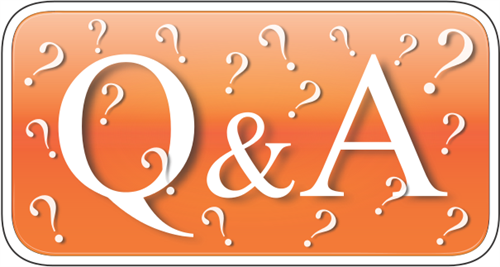
Premium NMN 20000は、美容と健康の両面をサポートするサプリメントとして注目されています。
しかい、初めて購入を検討する方にとっては「どのように飲めばいいの?」「効果はいつから?」など、気になることも多いはず。
ここでは、よくある質問とその回答をQ&A形式でまとめてみました。
Q:1日に何粒飲めばいいですか?
A:目安は1日3~4粒ですが、体調やライフスタイルに合わせて調整可能です。
多く摂取しても問題はありませんが、過剰摂取にならないよう注意しましょう。
自分に合ったリズムで無理なく続けることが大切です。
Q:副作用はありますか?
A:Premium NMN 20000は、食品としての安全性が確認されているNMNを使用しており、臨床試験で安全性が確認されているNMNです。
ただし、過剰摂取や体質によっては違和感を覚える場合もあるため、様子を見ながら取り入れましょう。
Q:他のサプリメントと併用しても大丈夫ですか?
A:基本的には問題ありません。
NMNは自然由来の成分であり、他の健康食品と併用しても相互作用の心配は少ないです。
ただし、一部の成分と重複する場合は、量に注意して使うのが安心です。
Q:いつ飲むのが効果的ですか?
A:特に決まりはありませんが、毎日決まった時間に摂ることで体に定着しやすくなります。
朝や就寝前など、自分の生活に合わせて「飲み忘れにくい時間帯」に習慣化するのが効果的です。
Q:妊娠中や授乳中でも飲めますか?
A:食品としての安全性は高いとされていますが、妊娠・授乳中の方は念のため、かかりつけ医にご相談ください。
お子さまへの影響を考慮し、個別判断を優先することが大切です。
Q:Premium NMN 20000はどこで作られていますか?
A:Premium NMN 20000は、国内のGMP認定工場で製造されています。
医薬品レベルの品質管理体制のもとで生産されているため、安心して口にできる品質です。
Q:定期コースの縛りはありますか?
A:Premium NMN 20000の定期購入には、回数縛りが一切ありません。
初回だけで解約も可能なので、安心して試すことができます。
Q:どんな人に向いていますか?
A:エイジングケアに興味がある方や、肌のハリ・体力の衰えを感じ始めた方におすすめです。
忙しくても簡単にインナーケアをしたい女性にぴったりのサプリです。
Premium NMN 20000の口コミ・評判まとめ!美と健康を本気で目指す女性に選ばれる理由
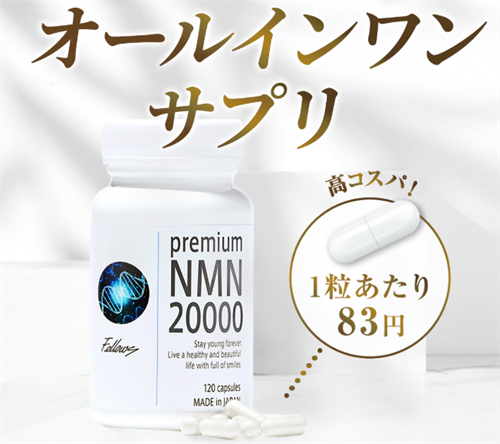
Premium NMN 20000は、多くの利用者から高評価を得ているNMNサプリメントで、肌のハリや明るさ、疲れにくさなどに実感の声が寄せられています。
特に「化粧ノリが良くなった」「朝の目覚めがスッキリした」など、美容と体調の両面に効果を感じたという口コミが多く、継続率の高さもうなずけます。
NMNが1瓶に20,000mgも配合されている点は業界トップクラスで、さらに10種類の美容成分が含まれているため、これひとつで内側からのエイジングケアが可能になります。
小粒で飲みやすく、無理なく続けやすいのも支持される理由のひとつです。
決して安価ではありませんが、成分の質や配合量を重視したい方には試す価値のあるサプリメントと言えるでしょう。
\ 高濃度NMNで理想の自分を! /
